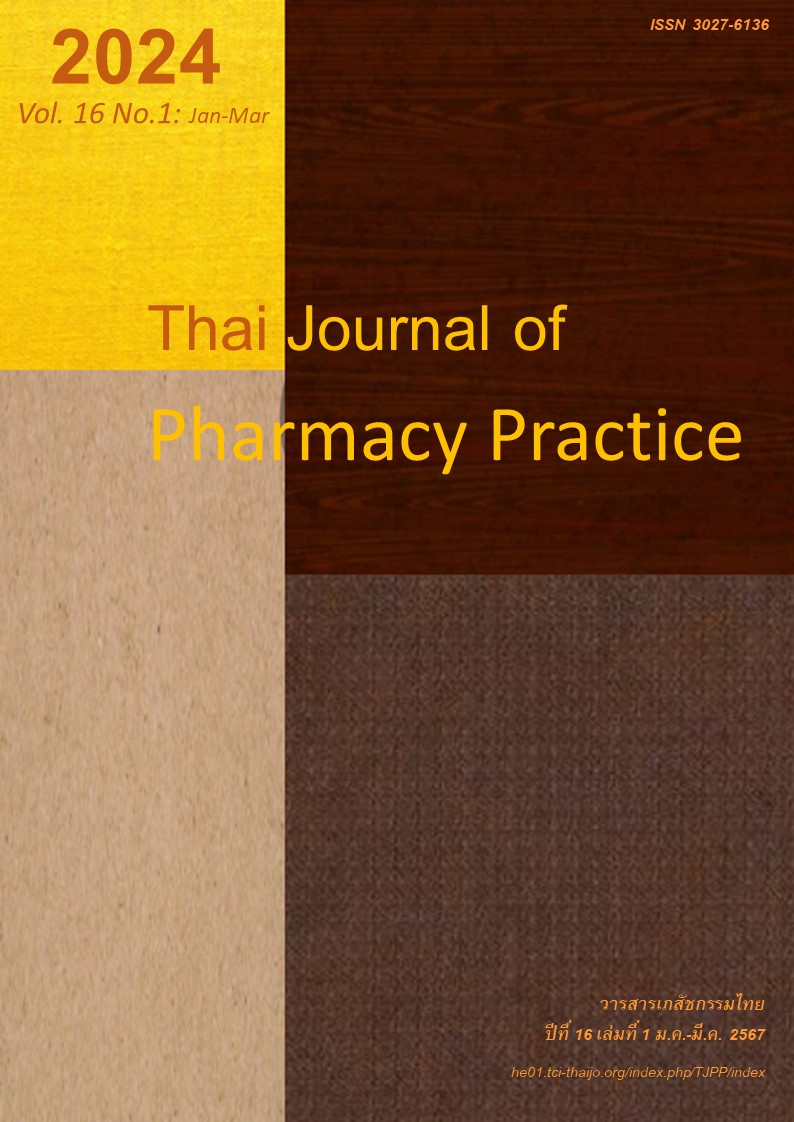การจัดการความคลาดเคลื่อนทางยาโดยใช้ทะเบียนความเสี่ยงใน โรงพยาบาลส่งเสริมสุขภาพตำบลแห่งหนึ่งในจังหวัดนครราชสีมา
Main Article Content
บทคัดย่อ
วัตถุประสงค์: เพื่อพัฒนาระบบลดความคลาดเคลื่อนทางยา (medication errors: MEs) ในโรงพยาบาลส่งเสริมสุขภาพตำบล (รพ.สต.) โดยใช้ทะเบียนความเสี่ยง วิธีการ: การศึกษานี้เป็นการวิจัยเชิงปฏิบัติการ แบ่งออกเป็น 4 ระยะ ได้แก่ 1) การระบุความเสี่ยงจากอุบัติการณ์การเกิด MEs 2) การวิเคราะห์ความเสี่ยงจากข้อมูลขนาดและระดับความรุนแรงของปัญหา 3) การรับมือกับความเสี่ยงโดยการระดมความคิดเพื่อออกแบบมาตรการลดความเสี่ยง และ 4) การติดตามและทบทวนความเสี่ยงจากข้อมูลอุบัติการณ์การเกิด MEs ภายหลังการใช้ทะเบียนความเสี่ยง ผู้วิจัยเก็บข้อมูลด้วยวิธีผสมผสาน วิธีการเชิงคุณภาพ ได้แก่ การสังเกต การสัมภาษณ์ และการประชุม ส่วนวิธีการเชิงปริมาณ ได้แก่ การทบทวนใบสั่งยา เพื่อวิเคราะห์อุบัติการณ์การเกิด MEs ผลการวิจัย: ปัญหาที่ถูกคัดเลือกมาขึ้นทะเบียนความเสี่ยงและวิเคราะห์สาเหตุราก ได้แก่ การจ่ายยาหมดอายุซึ่งมีความรุนแรงระดับ D การจ่ายยาผิดความแรงและการจ่ายยาผิดจำนวน ซึ่งเป็นอุบัติการณ์ที่พบบ่อย สำหรับมาตรการในการป้องกันยาหมดอายุ ได้แก่ การสร้างระบบตรวจสอบยาหมดอายุ มาตรการป้องกันการจัดยาผิดจำนวน ได้แก่ การปรับระบบการจัดยาให้ง่ายต่อการตรวจสอบจำนวน และปรับระบบการตรวจสอบซ้ำ ส่วนมาตรการป้องกันการจัดยาผิดความแรง ได้แก่ การติดสติ๊กเกอร์ชื่อยาคนละสี การปรับฉลากยาให้มีความแตกต่างกัน และการปรับระบบการตรวจสอบซ้ำ ภายหลังการนำทะเบียนความเสี่ยงมาใช้ พบว่า อุบัติการณ์การจัดยาผิดความแรงลดลงจากร้อยละ 0.12 เป็น 0.07 อุบัติการณ์จัดยาผิดจำนวนลดลงจากร้อยละ 0.24 เป็น 0.21 และอุบัติการณ์จ่ายยาหมดอายุลดลงจากร้อยละ 0.06 เป็น 0 เจ้าหน้าที่ รพ.สต. มีความเห็นว่า ทะเบียนความเสี่ยงเป็นเครื่องมือที่ทำให้สามารถมองเห็นภาพรวมของปัญหา แต่ทั้งนี้ควรมีการปรับแบบฟอร์มให้กระชับและง่ายต่อการบันทึกข้อมูล สรุป: การพัฒนาระบบป้องกัน MEs โดยใช้ทะเบียนความเสี่ยงมีแนวโน้มช่วยป้องกัน MEs ได้ แต่ในอนาคตควรมีการปรับแบบฟอร์มเพื่อให้สะดวกต่อการทำงาน
Article Details

อนุญาตภายใต้เงื่อนไข Creative Commons Attribution-NonCommercial-NoDerivatives 4.0 International License.
ผลการวิจัยและความคิดเห็นที่ปรากฏในบทความถือเป็นความคิดเห็นและอยู่ในความรับผิดชอบของผู้นิพนธ์ มิใช่ความเห็นหรือความรับผิดชอบของกองบรรณาธิการ หรือคณะเภสัชศาสตร์ มหาวิทยาลัยสงขลานครินทร์ ทั้งนี้ไม่รวมความผิดพลาดอันเกิดจากการพิมพ์ บทความที่ได้รับการเผยแพร่โดยวารสารเภสัชกรรมไทยถือเป็นสิทธิ์ของวารสารฯ
เอกสารอ้างอิง
World Health Organization. Medication errors: Technical series on safer primary care [online]. 2016 [cited Mar 21, 2020]. Available from: apps.who.int/iris/bitstream/handle/10665/252274/9789241511643-eng.pdf;jsessionid=A30EDF4FE5E 1595DF4CD5F0BDFA413B9?sequence=1.
Khaokom S, Sonthisombat P. A study of medication errors from prescribing by non-medical health providers for patients with chronic diseases following up at Sub-district Health Promoting Hospital, Laemngop District, Trat Province. Journal Of Phrapokklao Nursing College 2019; 30: 69-76.
Kunthong K, Fuangchan A. Development of medication service system to reduce medication error for patients with chronic diseases at Phakhai Primary Care Unit, Ayutthaya. Isan Journal of Pharmaceutical Sciences 2015; 11(Suppl): 82-8.
Phianthum C, Ploylearmsang C, Anusornsangiam W. Outcome of medication errors reduction procedure in Phukieo Health Promoting Hospitals, Chaiya phum Province. Isan Journal of Pharmaceutical Sciences 2018; 3: 116-29.
Lainer M, Mann E, Sonnichsen A. Information technology interventions to improve medication safety in primary care: a systematic review. Int J Qual Health Care 2013; 25: 590-8.
Toivo T, Dimitrow M, Puustinen J, Savela E, Pelkonen K, Kiuru V, et al. Coordinating resources for prospective medication risk management of older home care clients in primary care: procedure development and RCT study design for demon- strating its effectiveness. BMC Geriatr 2018; 18: 74. doi: 10.1186/s12877-018-0737-z.
The Healthcare Accreditation Institute (Public Organization). Patient safety goals: SIMPLE Thailand 2018. Chonburi: Famous and Successful; 2018.
The Healthcare Accreditation Institute (Public Organization). Hospital and healthcare standards 4th edition. Bangkok: One D Books; 2018.
World Health Organization. Corporate risk register organization-wide strategic risk management in WHO [online]. 2013 [cited Oct 20, 2020]. Available from: apps.who.int/gb/ebwha/pdf_files/EB133/B13 3_10-en.pdf?fbclid=IwAR3OM8S0rTDX_ojAs45m bBg3zMY2OktkPw-rEmqlGL2-Q_-eqTKfXj-NXAQ.
Li W, Zhu LL, Zhou Q. Safe medication use based on knowledge of information about contraindica- tions concerning cross allergy and comprehensive clinical intervention. Ther Clin Risk Manag 2013; 9: 65–72.
Chen L. The risk management of medical device-related pressure ulcers based on the Australian/ New Zealand Standard. J Int Med Res 2018; 46: 4129–39.
James GM, Robert AC, John SC, David FD, Cathie F. Using a quantitative risk register to promote learning from a patient safety reporting system. Jt Comm J Qual Patient Saf 2015; 41: 76-87.
Nørgaard LS, Sørensen EW. Action research in pharmacy practice. In: Babar, ZUD, editor. Pharmacy practice research methods. Switzerland: Springer; 2015.
Tewthanom K, Thananonniwas S. Medication error and prevention guide for patient’s safety. Veridian E-Journal, Silpakorn University (Humanities, Social Sciences and arts) 2009; 2: 195-217.
Rattanadetsakul C, Rattanadetsakul P. Risk register : drug risk management support tool [online]. 2018 [cited Mar 22, 2020]. Available from: ccpe.phar macycouncil.org/index.php?option=article_detail&subpage=article_detail&id=470.
Blondal AB, Sporrong SK, Almarsdottir AB. Intro ducing pharmaceutical pare to primary care in Iceland-an action research study. Pharmacy (Basel). 2017; 5: 23. doi: 10.3390/pharmacy5020 023.
Primary Health System Support Office. Guideline to development sub-district health promotion hospitals (5 stars SHPH) 2021 [online]. 2021 [cited Jun 26, 2022]. Available from: drive.google.com/file/d/1ToI gYSxVSZlqiCE7OoPHFNGM-qDg0iXZ/view.


